Microsoft Excel provides several functions purposed for counting different kinds of cells, such as blanks or non-blanks, with number, date or text values, containing specific words or character, etc.
In this article, we will focus on the Excel COUNTIF function that is purposed for counting cells with the condition you specify. First, we will briefly cover the syntax and general usage, and then I provide a number of examples and warn about possible quirks when using this function with multiple criteria and specific types of cells.
In essence, COUNTIF formulas are identical in all Excel versions, so you can use the examples from this tutorial in Excel 365, 2021, 2019, 2016, 2013, 2010 and 2007.
COUNTIF function in Excel - syntax and usage
Excel COUNTIF function is used for counting cells within a specified range that meet a certain criterion, or condition.
For example, you can write a COUNTIF formula to find out how many cells in your worksheet contain a number greater than or less than the number you specify. Another typical use of COUNTIF in Excel is for counting cells with a specific word or starting with a particular letter(s).
The syntax of the COUNTIF function is very simple:
As you see, there are only 2 arguments, both of which are required:
- range - defines one or several cells to count. You put the range in a formula like you usually do in Excel, e.g. A1:A20.
- criteria - defines the condition that tells the function which cells to count. It can be a number, text string, cell reference or expression. For instance, you can use the criteria like these: "10", A2, ">=10", "some text".
And here is the simplest example of Excel COUNTIF function. What you see in the image below is the list of the best tennis players for the last 14 years. The formula =COUNTIF(C2:C15,"Roger Federer") counts how many times Roger Federer's name is on the list:

Note. A criterion is case insensitive, meaning that if you type "roger federer" as the criteria in the above formula, this will produce the same result.
Excel COUNTIF function examples
As you have just seen, the syntax of the COUNTIF function is very simple. However, it allows for many possible variations of the criteria, including wildcard characters, the values of other cells, and even other Excel functions. This diversity makes the COUNTIF function really powerful and fit for many tasks, as you will see in the examples that follow.
COUNTIF formula for text and numbers (exact match)
In fact, we discussed the COUNTIF function that counts text values matching a specified criterion exactly a moment ago. Let me remind you that formula for cells containing an exact string of text: =COUNTIF(C2:C15,"Roger Federer"). So, you enter:
- A range as the first parameter;
- A comma as the delimiter;
- A word or several words enclosed in quotes as the criteria.
Instead of typing text, you can use a reference to any cell containing that word or words and get absolutely the same results, e.g. =COUNTIF(C1:C9,C7).
Similarly, COUNTIF formulas work for numbers. As shown in the screenshot below, the below formula perfectly counts cells with quantity 5 in Column D:
=COUNTIF(D2:D9, 5)
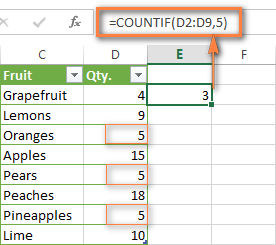
In this article, you will find a few more formulas to count cells that contain any text, specific characters or only filtered cells.
COUNTIF formulas with wildcard characters (partial match)
In case your Excel data include several variations of the keyword(s) you want to count, then you can use a wildcard character to count all the cells containing a certain word, phrase or letters as part of the cell's contents.
Suppose, you have a list of tasks assigned to different persons, and you want to know the number of tasks assigned to Danny Brown. Because Danny's name is written in several different ways, we enter "*Brown*" as the search criteria =COUNTIF(D2:D10, "*Brown*").
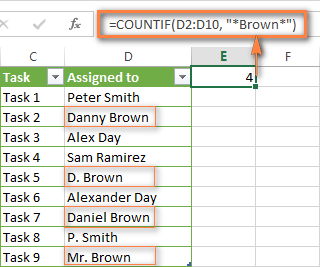
An asterisk (*) is used to find cells with any sequence of leading and trailing characters, as illustrated in the above example. If you need to match any single character, enter a question mark (?) instead, as demonstrated below.
Tip. It is also possible to use wildcards with cell references with the help of the concatenation operator (&). For example, instead of supplying "*Brown*" directly in the formula, you can type it in some cell, say F1, and use the following formula to count cells containing "Brown": =COUNTIF(D2:D10, "*"&F1&"*")
Count cells beginning or ending with certain characters
You can use either wildcard character, asterisk (*) or question mark (?), with the criterion depending on which exactly result you want to achieve.
If you want to know the number of cells that start or end with certain text no matter how many other characters a cell contains, use these formulas:
=COUNTIF(C2:C10,"Mr*") - count cells that begin with "Mr".
=COUNTIF(C2:C10,"*ed") - count cells that end with the letters "ed".
The image below demonstrates the second formula in action:
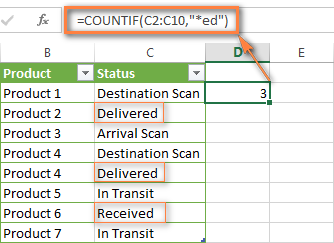
If you are looking for a count of cells that start or end with certain letters and contain the exact number of characters, you use the Excel COUNTIF function with the question mark character (?) in the criteria:
=COUNTIF(D2:D9,"??own") - counts the number of cells ending with the letters "own" and having exactly 5 characters in cells D2 through D9, including spaces.
=COUNTIF(D2:D9,"Mr??????") - counts the number of cells starting with the letters "Mr" and having exactly 8 characters in cells D2 through D9, including spaces.
Tip. To find the number of cells containing an actual question mark or asterisk, type a tilde (~) before the ? or * character in the formula. For example, =COUNTIF(D2:D9,"*~?*") will count all cells containing the question mark in the range D2:D9.
Excel COUNTIF for blank and non-blank cells
These formula examples demonstrate how you can use the COUNTIF function in Excel to count the number of empty or non-empty cells in a specified range.
COUNTIF not blank
In some Excel COUNTIF tutorials and other online resources, you may come across formulas for counting non-blank cells in Excel similar to this one:
=COUNTIF(A1:A10,"*")
But the fact is, the above formula counts only cells containing any text values including empty strings, meaning that cells with dates and numbers will be treated as blank cells and not included in the count!
If you need a universal COUNTIF formula for counting all non-blank cells in a specified range, here you go:
Or
This formula works correctly with all value types - text, dates and numbers - as you can see in the screenshot below.
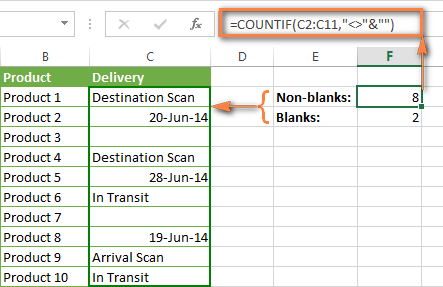
COUNTIF blank
If you want the opposite, i.e. count blank cells in a certain range, you should adhere to the same approach - use a formula with a wildcard character for text values and with the "" criteria to count all empty cells.
Formula to count cells not containing any text:
Since an asterisk (*) matches any sequence of text characters, the formula counts cells not equal to *, i.e. not containing any text in the specified range.
Universal COUNTIF formula for blanks (all value types):
The above formula correctly handles numbers, dates and text values. For example, here's how you can get the number of empty cells in the range C2:C11:
=COUNTIF(C2:C11,"")
Please be aware that Microsoft Excel has another function for counting blank cells, COUNTBLANK. For instance, the following formulas will produce exactly the same results as the COUNTIF formulas you see in the screenshot above:
Count blanks:
=COUNTBLANK(C2:C11)
Count non-blanks:
=ROWS(C2:C11)*COLUMNS(C2:C11)-COUNTBLANK(C2:C11)
Also, please keep in mind that both COUNTIF and COUNTBLANK count cells with empty strings that only look blank. If you do not want to treat such cells as blanks, use "=" for criteria. For example:
=COUNTIF(C2:C11,"=")
For more information about counting blanks and not blanks in Excel, please see:
COUNTIF greater than, less than or equal to
To count cells with values greater than, less than or equal to the number you specify, you simply add a corresponding operator to the criteria, as shown in the table below.
Please pay attention that in COUNTIF formulas, an operator with a number are always enclosed in quotes.
| Criteria | Formula Example | Description |
|---|---|---|
| Count if greater than | =COUNTIF(A2:A10,">5") | Count cells where value is greater than 5. |
| Count if less than | =COUNTIF(A2:A10,"<5") | Count cells with values less than 5. |
| Count if equal to | =COUNTIF(A2:A10,"=5") | Count cells where value is equal to 5. |
| Count if not equal to | =COUNTIF(A2:A10,"<>5") | Count cells where value is not equal to 5. |
| Count if greater than or equal to | =COUNTIF(C2:C8,">=5") | Count cells where value is greater than or equal to 5. |
| Count if less than or equal to | =COUNTIF(C2:C8,"<=5") | Count cells where value is less than or equal to 5. |
You can also use all of the above formulas to count cells based on another cell value, you will just need to replace the number in the criteria with a cell reference.
Note. In case of a cell reference, you have to enclose the operator in quotes and add an ampersand (&) before the cell reference. For example, to count cells in the range D2:D9 with values greater than a value in cell D3, you use this formula =COUNTIF(D2:D9,">"&D3):
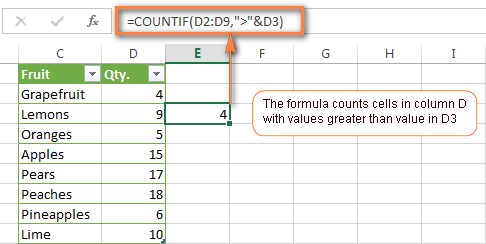
If you want to count cells that contain an actual operator as part of the cell's contents, i.e. the characters ">", "<" or "=", then use a wildcard character with the operator in the criteria. Such criteria will be treated as a text string rather than a numeric expression. For example, the formula =COUNTIF(D2:D9,"*>5*") will count all cells in the range D2:D9 with contents like this "Delivery >5 days" or ">5 available".
Using Excel COUNTIF function with dates
If you want to count cells with dates that are greater than, less than or equal to the date you specify or date in another cell, you proceed in the already familiar way using formulas similar to the ones we discussed a moment ago. All of the above formulas work for dates as well as for numbers. Let me give you just a few examples:
| Criteria | Formula Example | Description |
|---|---|---|
| Count dates equal to the specified date. | =COUNTIF(B2:B10,"6/1/2014") | Counts the number of cells in the range B2:B10 with the date 1-Jun-2014. |
| Count dates greater than or equal to another date. | =COUNTIF(B2:B10,">=6/1/2014") | Count the number of cells in the range B2:B10 with a date greater than or equal to 6/1/2014. |
| Count dates greater than or equal to a date in another cell, minus x days. | =COUNTIF(B2:B10,">="&B2-"7") | Count the number of cells in the range B2:B10 with a date greater than or equal to the date in B2 minus 7 days. |
Apart from these common usages, you can utilize the COUNTIF function in conjunction with specific Excel Date and Time functions such as TODAY() to count cells based on the current date.
| Criteria | Formula Example |
|---|---|
| Count dates equal to the current date. | =COUNTIF(A2:A10,TODAY()) |
| Count dates prior to the current date, i.e. less than today. | =COUNTIF(A2:A10,"<"&TODAY()) |
| Count dates after the current date, i.e. greater than today. | =COUNTIF(A2:A10,">"&TODAY()) |
| Count dates that are due in a week. | =COUNTIF(A2:A10,"="&TODAY()+7) |
| Count dates in a specific date range. | =COUNTIF(B2:B10, ">=6/1/2014")-COUNTIF(B2:B10, ">6/7/2014") |
Here is an example of using such formulas on real data (at the moment of writing today was 25-Jun-2014):

Excel COUNTIF with multiple criteria
In fact, Excel COUNTIF function is not exactly designed to count cells with multiple criteria. In most cases, you'd use its plural counterpart, the COUNTIFS function to count cells that match two or more criteria (AND logic). However, some tasks can be solved by combining two or more COUNTIF functions in one formula.
Count values between two numbers
One of the most common applications of Excel COUNTIF function with 2 criteria is counting numbers within a specific range, i.e. less than X but greater than Y. For example, you can use the following formula to count cells in the range B2:B9 where a value is greater than 5 and less than 15.
=COUNTIF(B2:B9,">5")-COUNTIF(B2:B9,">=15")

How this formula works:
Here, we use two separate COUNTIF functions - the first one finds out how many values are greater than 5 and the other one gets a count of values greater than or equal to 15. Then, you subtract the latter from the former and get the desired result.
Count cells with multiple OR criteria
In situations when you want to get several different items in a range, add 2 or more COUNTIF functions together. Supposing, you have a shopping list and you want to find out how many soft drinks are included. To have it done, use a formula similar to this:
=COUNTIF(B2:B13,"Lemonade")+COUNTIF(B2:B13,"*juice")
Please pay attention that we've included the wildcard character (*) in the second criterion, it is used to count all kinds of juice on the list.

In the same manner, you can write a COUNTIF formula with several conditions. Here is an example of the COUNTIF formula with multiple OR conditions that counts lemonade, juice and ice cream:
=COUNTIF(B2:B13,"Lemonade") + COUNTIF(B2:B13,"*juice") + COUNTIF(B2:B13,"Ice cream")
For other ways to count cells with OR logic, please see this tutorial: Excel COUNTIF and COUNTIFS with OR conditions.
Using COUNTIF function to find duplicates and unique values
Another possible usage of the COUNTIF function in Excel is for finding duplicates in one column, between two columns, or in a row.
Example 1. Find and count duplicates in 1 column
For example, this simple formula =COUNTIF(B2:B10,B2)>1 will spot all duplicate entries in the range B2:B10 while another function =COUNTIF(B2:B10,TRUE) will tell you how many dupes are there:

Example 2. Count duplicates between two columns
If you have two separate lists, say lists of names in columns B and C, and you want to know how many names appear in both columns, you can use Excel COUNTIF in combination with the SUMPRODUCT function to count duplicates:
=SUMPRODUCT((COUNTIF(B2:B1000,C2:C1000)>0)*(C2:C1000<>""))
We can even take a step further and count how many unique names there are in Column C, i.e. names that do NOT appear in Column B:
=SUMPRODUCT((COUNTIF(B2:B1000,C2:C1000)=0)*(C2:C1000<>""))
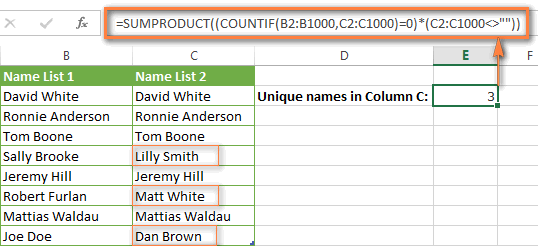
Tip. If you want to highlight duplicate cells or entire rows containing duplicate entries, you can create conditional formatting rules based on the COUNTIF formulas, as demonstrated in this tutorial - Excel conditional formatting formulas to highlight duplicates.
Example 3. Count duplicates and unique values in a row
If you want to count duplicates or unique values in a certain row rather than a column, use one of the below formulas. These formulas might be helpful, say, to analyze the lottery draw history.
Count duplicates in a row:
=SUMPRODUCT((COUNTIF(A2:I2,A2:I2)>1)*(A2:I2<>""))
Count unique values in a row:
=SUMPRODUCT((COUNTIF(A2:I2,A2:I2)=1)*(A2:I2<>""))

Excel COUNTIF - frequently asked questions and issues
I hope these examples have helped you to get a feel for the Excel COUNTIF function. If you've tried any of the above formulas on your data and were not able to get them to work or are having a problem with the formula you created, please look through the following 5 most common issues. There is a good chance that you will find the answer or a helpful tip there.
1. COUNTIF on a non-contiguous range of cells
Question: How can I use COUNTIF in Excel on a non-contiguous range or a selection of cells?
Answer: Excel COUNTIF does not work on non-adjacent ranges, nor does its syntax allow specifying several individual cells as the first parameter. Instead, you can use a combination of several COUNTIF functions:
Wrong: =COUNTIF(A2,B3,C4,">0")
Right: =COUNTIF(A2,">0") + COUNTIF(B3,">0") + COUNTIF(C4,">0")
An alternative way is using the INDIRECT function to create an array of ranges. For example, both of the below formulas produce the same result you see in the screenshot:
=SUM(COUNTIF(INDIRECT({"B2:B8","D2:C8"}),"=0"))
=COUNTIF($B2:$B8,0) + COUNTIF($C2:$C8,0)
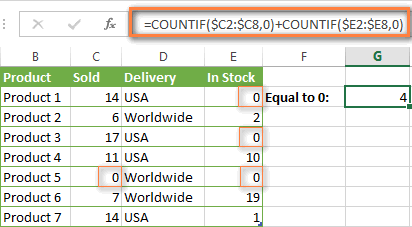
2. Ampersand and quotes in COUNTIF formulas
Question: When do I need to use an ampersand in a COUNTIF formula?
Answer: It is probably the trickiest part of the COUNTIF function, which I personally find very confusing. Though if you give it some thought, you'll see the reasoning behind it - an ampersand and quotes are needed to construct a text string for the argument. So, you can adhere to these rules:
If you use a number or a cell reference in the exact match criteria, you need neither ampersand nor quotes. For example:
=COUNTIF(A1:A10,10)
or
=COUNTIF(A1:A10,C1)
If your criteria includes text, wildcard character or logical operator with a number, enclose it in quotes. For example:
=COUNTIF(A2:A10,"lemons")
or
=COUNTIF(A2:A10,"*") or =COUNTIF(A2:A10,">5")
In case your criteria is an expression with a cell reference or another Excel function, you have to use the quotes ("") to start a text string and ampersand (&) to concatenate and finish the string off. For example:
=COUNTIF(A2:A10,">"&D2)
or
=COUNTIF(A2:A10,"<="&TODAY())
If you are in doubt whether an ampersand is needed or not, try out both ways. In most cases an ampersand works just fine, e.g. both of the below formulas work equally well.
=COUNTIF(C2:C8,"<=5")
and
=COUNTIF(C2:C8,"<="&5)
3. COUNTIF for formatted (color coded) cells
Question: How do I count cells by fill or font color rather than by values?
Answer: Regrettably, the syntax of the Excel COUNTIF function does not allow using formats as the condition. The only possible way to count or sum cells based on their color is using a macro, or more precisely an Excel User-Defined function. You can find the code working for cells colored manually as well as for conditionally formatted cells in this article - How to count and sum Excel cells by fill and font color.
4. #NAME? error in the COUNTIF formula
Issue: My COUNTIF formula throws a #NAME? error. How can I get it fixed?
Answer: Most likely, you have supplied an incorrect range to the formula. Please check out point 1 above.
5. Excel COUNTIF formula not working
Issue: My COUNTIF formula is not working! What have I done wrong?
Answer: If you have written a formula which is seemingly correct but it does not work or produces a wrong result, start by checking the most obvious things such as a range, conditions, cell references, use of ampersand and quotes.
Be very careful with using spaces in a COUNTIF formula. When creating one of the formulas for this article I was on the verge of pulling my hair out because the correct formula (I knew with certainty it was right!) wouldn't work. As it turned out, the problem was in a measly space somewhere in between, argh... For instance, look at this formula:
=COUNTIF(B2:B13," Lemonade").
At first sight, there is nothing wrong about it, except for an extra space after the opening quotation mark. Microsoft Excel will swallow the formula just fine without an error message, warning or any other indication, assuming you really want to count cells containing the word 'Lemonade' and a leading space.
If you use the COUNTIF function with multiple criteria, split the formula into several pieces and verify each function individually.
And this is all for today. In the next article, we will explore several ways to count cells in Excel with multiple conditions. Hope to see you next week and thanks for reading!
 by
by
1067 comments
Hi,
I have Year in Column A (from 2005-2012), names of countries in Column B (like India, Australia, England, South Africa, etc.) and whether they "Win" or "Loss" in Column C. How do I use the Countif function to determine how many times India Won in total?
Vani:
Not sure about using COUNTIF. You can use COUNTIFS like this:
=COUNTIFS(A20:A27,"India,C20:C27,"Win")
Thanks a lot. It full fill my requirement.
=COUNTIF(IF((B2:B1000="India")+(C2:C1000="Win")=2;1);1)
={COUNTIF(IF((B2:B1000="India")+(C2:C1000="Win")=2;1);1)}
Remember, it is an array formula. Control+Shift+Enter
How can I use COUNTIF to check for duplicated entries in excel?
For example, if I have this the file below, how can CountIF show where the same STAN duplicates.
STAN Output
1234
2345
1234
5678
890
5678
6930
Edozie:
Where the STAN data is in A2:A8 the formula is:
=COUNTIF($A$2:$A$8,A2)>1 then copy it down the column.
Hi All,
=COUNTIFS(G:G, "12345",F:F, "Entry",E:E, "=500")
This formula counts well for the occurrence of the number 12345 with respect to the matching value in column E and F as mentioned in the formula.
But to make the formula worked for the next number below 12345, how will I point the next cell in this formula for the column G.
Basically I need mention the cell (G) instead of number in this formula. Tried many ways.. cudnt win.
Please help.
How to compare a condition between two table using COUNTIF function?
I mean suppose I have a column containing 'responsible party' name and another one 'rectification status'. How can I search for a condition between them using COUNTIF function?
I would like to make count of repeats in a column where another cell is blank.
Example
Number of times orange repeating where price of orange is $0.5
Another example
Number of times persons visited Dubai from Japan
Name Visited to from which country
ABC1 Dubai Japan
ABC2 Paris Japan
ABC3 Dubai China
ABC4 London Japan
ABC5 Dubai Japan
Here the answer is 2
Hey would anyone know how to use COUNTIF to compare two columns of data - dates, only counting IF the first column date is proir to the second? 30,000 data points so I cannot do it manually
Nick:
I think this is what you're looking for:
=COUNTIF(E6,">"&D6)
Where the dates are in columns E and D beginning in row 6 enter this in column F.
IFEOLUWA AKINNLO W/D ENGINEER
RAWLINGS U UWUIM BRC OPERATOR
JIMOH ISHMAEL AD W/D OPERATOR
AKANDU OKECHUKWU ELE Electrician
HENRY EYO DAVIS ELE Electrician
JOHN ETIM W/D OPERATOR
FRANKLIN IGHOROD ELE HOD
LASISI OLADIPUPO ELE D.G OP
ALEX ADEWOLE W/D OPERATOR
JIMOH RASAQ W/D OPERATOR
ADELEKE KAZEEM BRC OPERATOR
I WANT TO COUNT HOW MANY OPERATOR PRESENT DATE WISE. USING COUNTIF FUNCTION.
Dillip:
If the data is in the range A2:C27 the formula in D2 looks like:
=COUNTIF(A2:C27,"Operator")
For some reason the COUNTIF formula with dates isn't working on my spreadsheet. Say I have a list of dates in M/DD/YYYY format across multiple rows and columns. I want to use a formula to count how many of those dates fall into a particular week.
A B C D
1 4/26/2018 5/08/2018 5/15/2018 5/17/2018
2 4/26/2018
3 4/24/2018
4 4/26/2018 5/15/2018
5 4/24/2018
6 4/30/2018 5/16/2018
7 4/23/2018 4/30/2018 5/17/2018 5/14/2018
=COUNTIFS(A1:D7,">=&4/20/2018",A1:D7,"<&4/30/2018")
It should return 7, right? So why is it returning 13? I use the "&" because otherwise the value returns a 0. I'd appreciate the help.
Jon:
Does your Excel version support COUNTIFS? I use COUNTIFS for this and got the correct number which is 6.
=COUNTIFS(O23:R29,">=4/20/18",O23:R29,"<4/30/18")
When I changed the second criteria to be "<=4/30/18" the result is 8.
I'm working on a project and need to use greather or lesser than in the same Countif statement, can anyone help me can't seem to get it right.
Hi,
I'm trying to count if there was growth in a period and how much time the growth has sustained. So I need to start my count in a values greater than 0 to determine the length of time. My problem is, starting a count on the first negative number in a column determined by time, not counting every positive number in the same time series.
So I was wondering if and how you can set the criteria of COUNTIF so that one row equals another? Meaning I want to count B2:B100 if it equals A2:A100, in other words counting how many times column B equals column A in the same row.
In column C, I would add an if statement.
if(A2=B2,1,0) then AutoSum (or countif) column C.
Just found a better (quicker) way!!!
=SUMPRODUCT(0+(A2:A15=B2:B15))
Thanks, Barry! https://superuser.com/a/846065
I'm having trouble with a formula. I have =IF(COUNTIF(C2:C6,C2)=5,"YES","NO") and it works beautifully, except that I also need the result cell to remain blank if any of the cells C2:C6 are left blank. Help?
Hello
"If you want to count cells that contain an actual operator as part of the cell's contents, i.e. the characters ">", "<" or "=", then use a wildcard character with the operator in the criteria." It saved my life. Thank you
I'm trying to be able to take a column and count unique values (non-duplicates) and not count blanks. Haven't found the formula yet.
Ex. We assign ID numbers to each rqst submitted. I keep track on a spreadsheet. Each # may be used for multiple locations so they can appear more than once. I want to know how many unique ID#s I have and not count the blank cells (that are holding for new data to be entered).
Hi Can you assist,
I am using a countif formula and want to include indirect to count the number of "P" between 2 dates. I have this formula working but cant seem to get to work using indirect as get #value I want to use indirect as I have several similar sheets and just want 1 summary page.
Working formula not using indirect
=COUNTIFS(Sample!6:6,">="&B5,Sample!6:6,"="&B5),(INDIRECT("'"&$G$2&"'!"&$C6,"<="&C5),(INDIRECT("'"&$G$2&"'!"&$C8),I$7)))
G2=Sheetname which one is called sample
C6=6:6
C8=8:8
B5=From date
B6=To date
I7=P
Thanks
Matt
how do I get countif to count the value in a cell, i.e. if the cell references another cell or is a formula, "=H40" countif will not count the value in the cell, but only what is written in the cell. How do I work around this???
will yes counties does work on some formulas but not the one I am interested in
=COUNTIFS($H$50:$L$50,"=10")
will not count the output of
=TEXTJOIN("",TRUE,IFERROR(MID(H49,ROW(INDIRECT("1:100")),1)+0,""))
there are values in the cells that countif just does not see and all I get is zero.
found the problem numbers were being stored as text
Hi,
Need to count the days in Excel between two values in the same column.
For EX: How to count the value between less than 15 and greater than 30 days
please help... my professor asked as to count the name of anne so we make the formula =countif(A1:A12,"*anne*") but we need to make the string color green when the excel counts the name anne... what formula should we use? please i need answer in this confusing activity
Hi Paula,
To color cells or entire rows based on a cell value, you need to create a conditional formatting rule with a formula. In your case, the formula is as follows:
=SEARCH("anne", $A1)>0
The detailed steps to create a rule can be found here:
How to create a conditional formatting based on formula
i want to fine a value for a cell based on database
number value need ?
5 1 5 what is value
8 2
2 3
Hello, Sameer,
It looks like the VLOOKUP function will work for you.
Please find more information about VLOOKUP in this article.
Helllo - Please can you assist.
I am currently using the following formula and when there is nothing to display it shows a 0 how do I change the formula to show blank instead of 0
=COUNTIF(Table1113[@[CCN1]:[Plant & Appliances in Non Domestic Premises]],">"&TODAY())
many thanks
I would use the following to hide 0 results:
=if(COUNTIF(Table1113[@[CCN1]:[Plant & Appliances in Non Domestic Premises]],">"&TODAY())=0,"",COUNTIF(Table1113[@[CCN1]:[Plant & Appliances in Non Domestic Premises]],">"&TODAY()))
I am sure there are better answers than this, but it works for me.